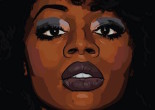Rising Fog Becomes Cloud
by Michael McFadden
We live in a period of rapid globalization, the speed of which only increases exponentially as time goes on. This, in and of itself, is not a bad thing, but couple it with the speed at which we as humans develop and act upon whims, and you have a world of people acting and reacting with an immediacy unparalleled in the existence of our species. In a time such as this, it is becoming increasingly important that we look to the idealized state of the enlightened being for guidance and comfort.
In his artistic practice, Tae Lee does just that. Currently on display at BLUEOrange Gallery, Lee’s rising fog becomes cloud, guest curated by Ken General, turns an up-and-coming art gallery into a meditative space in which visitors can explore and ruminate on ideas related to enlightenment and the individual journey that one must take to attain it. With a mix of drawings and paintings, Lee’s series expands on the Jungian concept of the anima — one’s feminine inner personality — in an attempt to bring physical form and reflection to this aspect of the unconscious mind. Building on this idea, Lee moves from the anima as an idea to the anima as a sort of representative character.
Throughout the gallery, the anima takes different forms and characteristics, each representative of Lee’s thoughts on the unconscious mind, the physical body, enlightenment, and the tools needed to attain it: particularly empathy, balance, and clarity.
“Sympathy is condescending.”
Said Lee in conversation. While many believe in the power of sympathy, Lee finds it unproductive. “Empathy is the highest point of human intellect. If you know the circumstances of a person’s history, it eliminates arbitrary judgement of sinner vs saint, kind vs mean, worthy vs unworthy.” He considers empathy to be much more powerful than sympathy, which by its own nature requires a sense of patronizing superiority, coming from a situation in which a person believes he or she is in a position of higher standing than the one the connection is made with, while empathy comes from a sense of clarity on the chaotic yet natural flow of the material world.

This idea becomes immediately apparent as you look upon the faces of the anima in his paintings. Reminiscent of a religious icon, the faces portray a commonality among Holy figures that is profound. “From the faces of Buddha in meditation or Mother Mary bowing her head in prayer, there seems to be a look that to me represents empathy,” Lee stated. No matter what is happening to a holy figure, whether the Buddha rests or Christ hangs on the cross, they seem to look back upon viewers with empathy, and Lee reflects this in his representations of the anima. Whether an anima is tied up, split in two, or missing appendages, they don’t seek sympathy from viewers, instead offering the world empathy.
Seeking Calm in Balance
When asked if he felt comfortable in a state of clarity, he was thrown temporarily off-balance. Ultimately, he settled on a simple “no.” From a point of clarity, when you take into context everything that is possible — or simply move into a state of abstraction through deep thought — finding balance becomes all the more important. “Balance,” Lee said, “represents the wisdom to go on living in this world with the sometimes painful flashes of clarity and empathy.”
Regardless of whether your eventual goal is enlightenment, we all seek some sense of balance. It might be a steady job and a nuclear family, or it might be supporting your artistic practice through less-than-enjoyable work. When it all comes to a head, we are just people trying to exist and live day to day. In order to not lose ourselves in abstraction, we must decide to remain positive.
“Within all of this talk of rumination and intellectual yoga, there has to be a faith that makes life worth living,” Lee stated. “Happiness is the most helpful barometer we have!” Reflected in the soft tones and thoughtful placement of the images, balance plays a key part in the meditative quality of Lee’s exhibition. Yet, in the back room of the gallery, while still balanced between two walls, a series of drawings offers another look into the ideas and worlds that Lee looks to for inspiration.
Clarity as the Peak Ideal
In this back room, viewers get a sense that they are looking through a series of windows into different worlds. Anima adorn the walls, but where the main gallery space provides a more straightforward connection, this space allows viewers to look from a point of clarity. “Clarity is the peak ideal we should ruminate on,” Lee offered. “Temporary judgement calls on situations in life can be marred by misinformation or lack of complete information.”

So many of our actions are a product of so many different circumstances. Taking a look from Lee’s perspective of clarity, viewers see the anima occupy their own space, engaging their own worlds, and living, growing, being while maintaining the same sense of empathy. The exhibition’s title - rising fog becomes cloud - itself offers insight. As we rise from the fog of the world we occupy, we can gain the perspective of the cloud, assimilating the goings on of the world as well as its history, and looking upon it, and ourselves, with empathy, balance, and clarity.














